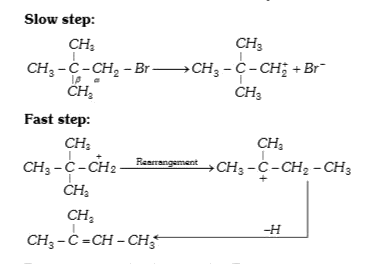Neopentyl bromide undergoes dehydro halogenation to give alkene even though it has no β− hydrogen. This is due to :
E2 mechanism
E1 mechanism
Due to rearrangement of carbocation by E1 mechanism
E1 do mechanism
The correct Answer is:C

Rearrangement of carbocation by E1 mechanism
Topper's Solved these Questions
- BOOK - ERRORLESSCHAPTER - GENERAL ORGANIC CHEMISTRY EXERCISE - NCERT BASED QUESTIONS (Structural and Stereo Isomerism )99videos
GENERAL ORGANIC CHEMISTRY
- BOOK - ERRORLESSCHAPTER - GENERAL ORGANIC CHEMISTRY EXERCISE - PAST YEARS QUESTIONS85videos
GENERAL ORGANIC CHEMISTRY
- BOOK - ERRORLESSCHAPTER - GENERAL ORGANIC CHEMISTRY EXERCISE - NCERT BASED QUESTIONS (Dipole Moment, Resonance and Reaction Intermediates )70videos
GENERAL ORGANIC CHEMISTRY
- BOOK - ERRORLESSCHAPTER - ENVIRONMENTAL CHEMISTRYEXERCISE - ASSERTION & REASON7videos
ENVIRONMENTAL CHEMISTRY
- BOOK - ERRORLESSCHAPTER - HYDROCARBONSEXERCISE - ASSERTION & REASON18videos
HYDROCARBONS
Similar Questions
Knowledge Check
- Question 1 - Select One
Neopentyl bromide undergoes dehydrohalogenation to give alkene even though it has no β -hydrogen. This is due to :
AE2 mechanismBE1 mechanismCHofmann eliminationDrearrangement of carbocation by E1 mechanism - Question 2 - Select One
Neopentyl bromide undergoes dehydrohalogenation to give alkene even though it has no β -hydrogen. This is due to :
AE2 mechanismBE1 mechanismCDue to rearrangement of carbocation by E1 mechanismDE1 cb mechanism - Question 3 - Select One
The removal of two atoms or groups one generally hydrogen (H+) and the other a leaving group (L−) resulting in the formation of unsaturated compound is known as elimination reaction.

In E1 (elimination) reactions the C-L bond is broken heterolytically (in step 1) to form a carbocation (as inSN1 reaction) in which (L−) is lost (rate determining step). The carbocation (in step 2) loses a proton from the β− carbon atom by a base (nucleophile) to form an alkene. E1 reaction is favoured in compounds in which the leaving group is at secondar (2∘) or tertiary(3∘) Position.
In E2 (elimination) reactions two sigma bonds are broken and a π−bond is formed simultaneously.E2 reactions occur in one step through a transition state.

E2 reactions are most common in haloalkanes (particulary 1∘) and better the leaving group higher is the E2 reaction. In E2 reactions, both the leaving groups should be antiplaner.
E1cb (Elimination unimolecular conjugate base) reaction involves the removal of proton by a conjugate base (step 1) to produce carbanion which loses a leaving group to form an alkene (step 2) and is a slow step Neopentyl bromide undergoes dehydrohalogenation to give alkene even though it has no β−hydrogen.This is due to :AE2mechanismBE1 mechanismCdue to rearrangement of carbocation by E1 mechanismDE1 cb mechanism
Neopentyl bormide, undergoes dehydrohalogenation to give alkenes even though it has no β−H. This is due to
View SolutionAn alkyl halide with β-hydrogen atoms on reaction with a base or a nucleophile has two competing paths. Substitutions (SN1 and SN2) and elimination (E1 and E2). The path adopted by them depends upon the nature of the alkyl halide, strength and size of the base/nucleophile and reaction conditions. The bulkiers nucleophile prefers to act as a base and abstracts a proton rather than approaching a tetravalent carbon atom (due to steric reasons) and vise versa. A primary alkyl halide can react by any of the four mechanism (SN2,SN1,E2 and E1) depending upon the stability or the intermediate carbocation or the substituted alkene formed and the reaction conditions and tertiary alkyl halide. The three possible paths (SN1,E1 and E2)
Neopentyl bromide undergoes dehydrohalogenations to give alkene though it has no β-hydrogen. This is dueView Solution2,3-Dimethyl-2-butene undergoes catalytic hydrogenation to give
View SolutionThe dehydrohalogenation of neopentyl bromide with alcoholic KOH mainly gives
View SolutionNeopentyl bromide is heated with an alcoholic KOH solution. The major alkene formed is
View Solution

